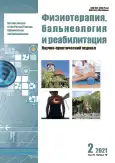Transdermal electroneurostimulation in patients with diabetic neuropathy
- Authors: Al-Zamil M.K.1,2, Kulikova N.G.1,3
-
Affiliations:
- Peoples' Friendship University of Russia
- "Olivia" Brain and Spine Clinic
- National Medical Research Center for Rehabilitation and Balneology
- Issue: Vol 20, No 2 (2021)
- Pages: 119-124
- Section: Original studies
- Published: 15.03.2021
- URL: https://rjpbr.com/1681-3456/article/view/89998
- DOI: https://doi.org/10.17816/1681-3456-2021-20-2-3
- ID: 89998
Cite item
Abstract
BACKGROUND: The dynamics of pain syndrome determined using various algic tests in the treatment of patients with diabetic neuropathic pain syndrome using tansdermal electroneurostimulation has been little studied.
AIMS: To study the dynamics of projection zones of neuropathic pain syndrome in patients with diabetic polyneuropathy while using TENS.
MATERIAL AND METHODS: 75 patients with diabetic polyneuropathy were examined. The control group (n=25; 33.3%) received a course of standard pharmacotherapy. The main group consisted of 2 groups. The first group (n=25; 33.3%) underwent a course of high-frequency low-amplitude (HL TENS) transdermal electroneurostimulation, and the second group (n=25; 33.3%) underwent a course of low-frequency high-amplitude (LH TENS) therapy. Pain syndrome was determined using a visual analogue scale (VAS) and a body diagram before, after treatment and in the long-term period.
RESULTS: Using a visual analogue scale (VAS), the dynamics of pain syndrome after the use of LF TENS was lower than after the use of HFTENS by an average of 35% (p <0.05).
The data obtained indicate that the regression of pain syndrome after physiotherapeutic treatment of TENS in patients from the main comparison groups exceeds similar indicators in patients from the control group by an average of 63% (p <0.05) both immediately after the course of exposure and in the distant the observation period by 23%. Against the background of TENS, the area of pain syndrome according to the body pattern significantly decreased by 53% after treatment (p <0.05) and by 65.6% in the long-term period (p <0.05), compared with a decrease in the area of pain syndrome in the control group.
CONCLUSION: There were revealed significant differences between the quantitative and projection forms of pain measurement. The use of TENS enhances the analgesic effect of drug therapy in the treatment of diabetic neuropathic pain syndrome by 1.37 times while maintaining this effect without negative dynamics for 2 months after the end of the course of non-drug therapy. The developed technique for assessing pain syndrome using a body diagram in combination with a visual analogue scale (VAS) in patients with diabetic polyneuropathy provides a more reliable assessment of pain syndrome.
Full Text
About the authors
Mustafa Kh. Al-Zamil
Peoples' Friendship University of Russia; "Olivia" Brain and Spine Clinic
Author for correspondence.
Email: fbrmed@mail.ru
ORCID iD: 0000-0002-3643-982X
SPIN-code: 3434-9150
MD, Dr. Sci. (Med.), Professor
Russian Federation, Moscow; PodolskNatalia G. Kulikova
Peoples' Friendship University of Russia; National Medical Research Center for Rehabilitation and Balneology
Email: fbrmed@mail.ru
ORCID iD: 0000-0002-6895-0681
SPIN-code: 1827-7880
MD, Dr. Sci. (Med.), Professor
Congo, Moscow; MoscowReferences
- Al-Zamil MH. Clinical and morphological correlations in lumbar osteochondrosis [dissertation abstract]. Moscow; 2005. 28 p.
- Bril V, England J, Franklin G, et al. Evidence-based guideline: treatment of painful diabetic neuropathy: report of the American Academy of Neurology, the American Association of Neuromuscular and Electrodiagnostic Medicine, and the American Academy of Physical Medicine and Rehabilitation. Neurology. 2011;76(20):1758–1765. doi: 10.1212/WNL.0b013e3182166ebe
- Kulikova NG, Deryagina LE, Bezrukova OV. Physiotherapeutic correction of antioxidant indicators of homeostatic status in patients with discogenic pathology. Human Ecology. 2018;(10):58–64.
- Thakral G, Kim P, Lafontaine J, et al. Electrical stimulation as an adjunctive treatment of painful and sensory diabetic neuropathy. J Diabetes Sci Technol. 2013;7(5):1202–1209. doi: 10.1177/193229681300700510
- Javed S, Petropoulos IN, Alam U, Malik RA. Treatment of painful diabetic neuropathy. Ther Adv Chronic Dis. 2015;6(1):15–28. doi: 10.1177/2040622314552071
- Tachibana T, Maruo K, Inoue S, et al. Use of pain drawing as an assessment tool of sciatica for patients with single level lumbar disc herniation. Springerplus. 2016;5(1):1312. doi: 10.1186/s40064-016-2981-z









